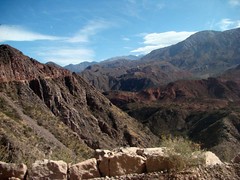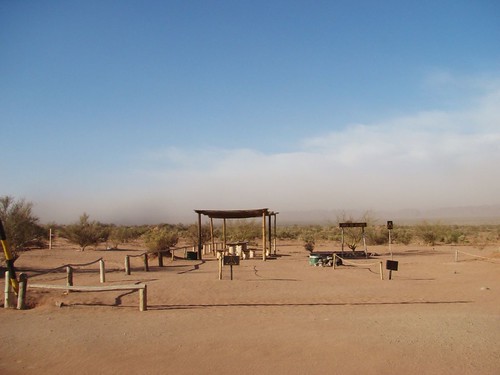 Carrying our mate gear, some warm clothing, and the compulsory cap and sunblock, we exited Chilecito, passed by Nonogasta, and then the Cuesta de Miranda, between the mountains (I'm not going to refer to this beautiful place right now). Then we took a dirt road, asphalted road, dirt again, a couple of sleepy villages, and finally we came up to the entrance gate of the Talampaya National Park. A strong wind was blowing, and dust flew around.
Carrying our mate gear, some warm clothing, and the compulsory cap and sunblock, we exited Chilecito, passed by Nonogasta, and then the Cuesta de Miranda, between the mountains (I'm not going to refer to this beautiful place right now). Then we took a dirt road, asphalted road, dirt again, a couple of sleepy villages, and finally we came up to the entrance gate of the Talampaya National Park. A strong wind was blowing, and dust flew around.The guide got off the van to record our entry and came back after a while. "People, the park is closed", he said calmly. For two whole second I stared at him, waiting for some laughter to emerge after what was indoubtedly a joke told to every tourist — una jodita, as we say in Argentina. It wasn't. It was the truth.
Only then we realized the wind was blowing stronger and stronger. It was the zonda, a dry wind that comes down from the mountains and is felt by the Cuyo provinces of central and central-northern Argentina at the foot of the Andes. This zonda brought reddish dust and sand in incredible amounts and at a terrible speed. It was just starting and the horizon was already vanishing, blurred out of sight by a brown mass of the color of Talampaya's iron-laden sand. Not only sightseeing or taking pictures would be impossible, but anything could fly away, or come flying with, such a wind.
We stayed there for a while to inquire about the park rangers' opinion. The zonda was going to last for a few hours at least, and even after that there would be too much suspended dust. It was entirely likely that the wind wouldn't stop during the whole day.
Dispirited, we took the road back to Chilecito. The zonda's entry way among the mountains could be seen clearly at a distance of a few kilometres: a uniform opaque brownish jet that ran and expanded after us. To my surprise, I noticed I was resigned, even content. The trip to the park and view on the way had been fabulous. I had no right to complain because an unforeseeable weather incident had ruined the main tour. We would have a new chance two days later.
We got back to Chilecito after midday. The zonda had arrived as well. The sky and the tops of the hills had disappeared, swallowed by the enveloping brown cloud. It was cooler than the day before, so off we went to see cacti... which I'll come to later.


No comments:
Post a Comment
Note: Only a member of this blog may post a comment.